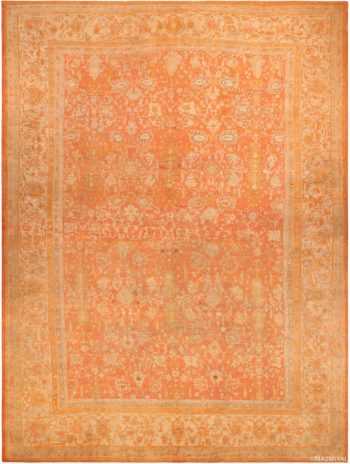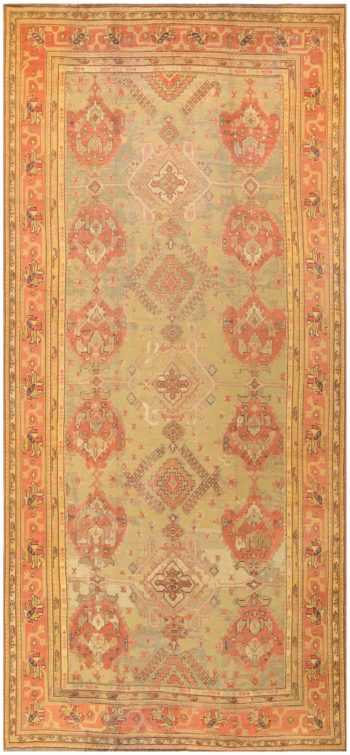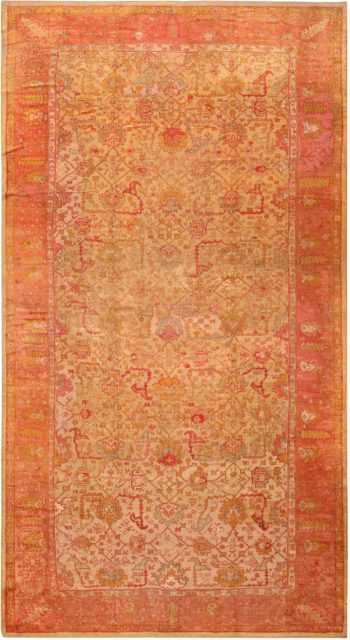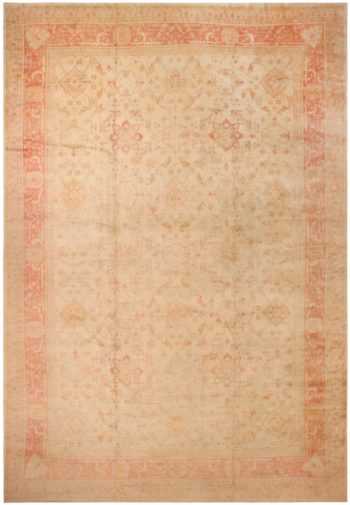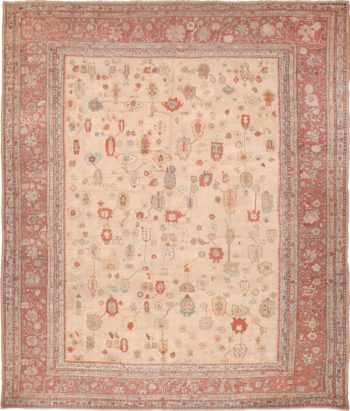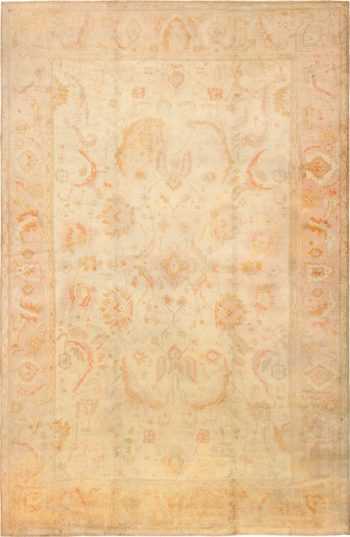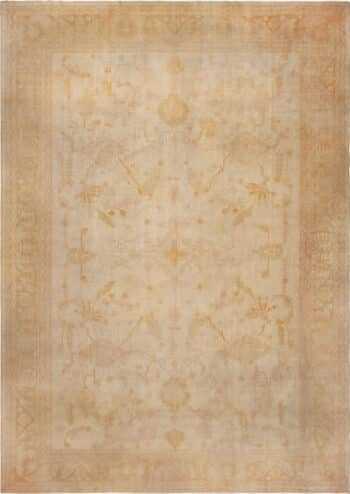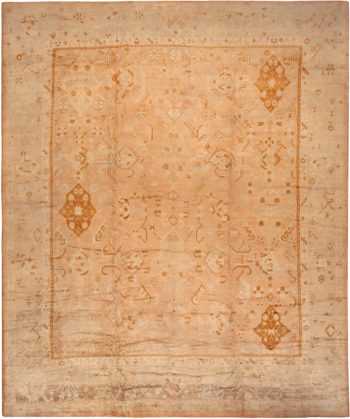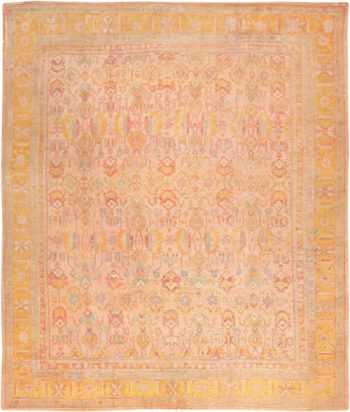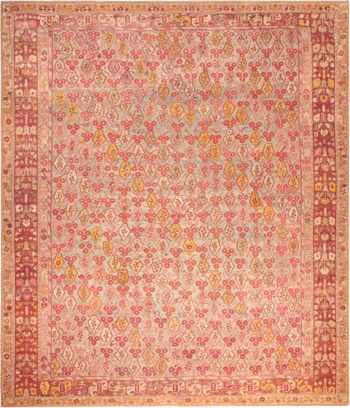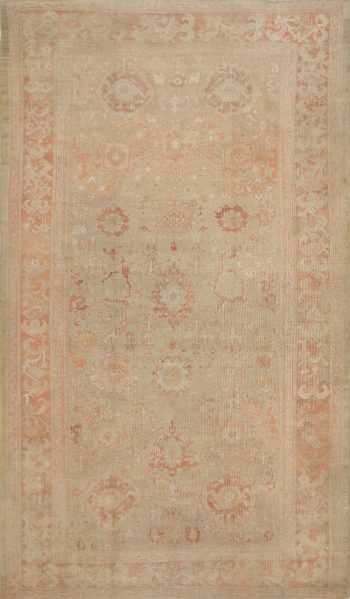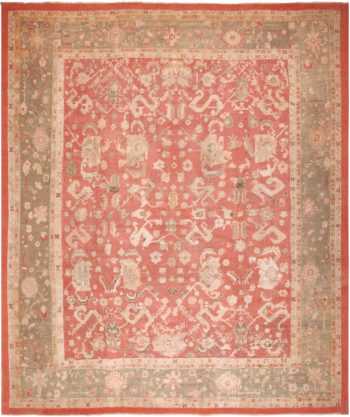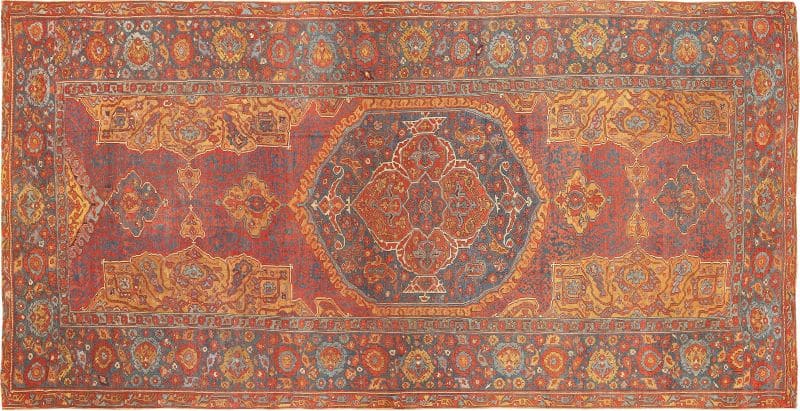Antique Turkish Rugs
Make A Statement With Our Antique Turkish Rug Masterpieces
View tribal and vintage decorative antique Turkish rugs:
-
Oversized Decorative Antique Turkish Oushak Carpet 71632
$165,000.00Size: 20 ft x 26 ft 6 in (6.1 m x 8.08 m) -
Antique Oversized Turkish Oushak Rug 50239
$24,000.00Size: 11 ft 8 in x 25 ft (3.56 m x 7.62 m) -
Oversized Tribal Antique Turkish Oushak Shabby Chic Rug 50199
Size: 16 ft 3 in x 24 ft 7 in (4.95 m x 7.49 m) -
Antique Oversized Animal Hunting Scene Turkish Hereke Rug 45620
$185,000.00Size: 17 ft 2 in x 23 ft 9 in (5.23 m x 7.24 m) -
Oversized Antique Shabby Chic Turkish Oushak Rug 70877
Size: 12 ft x 22 ft 8 in (3.66 m x 6.91 m) -
Beautiful Warm Decorative Oversized Vintage Ivory Cream Turkish Oushak Allover Rug 71966
Size: 14 ft 8 in x 22 ft (4.47 m x 6.71 m) -
Antique 17th Century Turkish Smyrna Rug 70267
$125,000.00Size: 11 ft 8 in x 21 ft 3 in (3.56 m x 6.48 m) -
Large Rich Rustic Red Color Antique Allover Tribal Design Turkish Oushak Rug 71413
$88,000.00Size: 16 ft 4 in x 20 ft (4.98 m x 6.1 m) -
Large Ivory Background Tribal Antique Turkish Oushak Rug 49658
$76,000.00Size: 15 ft 10 in x 19 ft 7 in (4.83 m x 5.97 m) -
Large Oversized Cream Antique Decorative Turkish Oushak Rug 49166
Size: 12 ft 8 in x 19 ft 7 in (3.86 m x 5.97 m) -
Antique Geometric Turkish Oushak Rug 72847
Size: 13 ft 6 in x 18 ft 8 in (4.11 m x 5.69 m) -
Large Square Allover Tribal Design Antique Soft Seafoam Green Turkish Ghiordes Rug 71443
$125,000.00Size: 15 ft 6 in x 18 ft 7 in (4.72 m x 5.66 m) -
Large Pastel Antique Ivory Turkish Oushak Area Rug 48473
Size: 15 ft x 18 ft 6 in (4.57 m x 5.64 m) -
Large Soft Washed Out Antique Turkish Oushak Rug 71508
$42,000.00Size: 12 ft 6 in x 17 ft 10 in (3.81 m x 5.44 m) -
Decorative Large Antique Turkish Oushak Rug 70519
Size: 14 ft 10 in x 17 ft 7 in (4.52 m x 5.36 m) -
Large Soft Decorative Coral Color Antique Tribal Allover Design Turkish Oushak Rug 47427
$89,000.00Size: 14 ft 7 in x 17 ft 6 in (4.44 m x 5.33 m) -
Large Antique Turkish Ghiordes Area Rug 70394
$58,000.00Size: 15 ft 5 in x 17 ft 4 in (4.7 m x 5.28 m) -
Antique Turkish Oushak Rug With Arts and Crafts Design 49146
$38,000.00Size: 8 ft 4 in x 17 ft 3 in (2.54 m x 5.26 m) -
Large Ivory Background Allover Design Vintage Turkish Sivas Carpet 50327
$36,000.00Size: 11 ft 9 in x 17 ft 3 in (3.58 m x 5.26 m) -
Soft Decorative Large Scale Allover Design Antique Rustic Turkish Oushak Carpet 71268
$69,000.00Size: 10 ft 3 in x 17 ft 3 in (3.12 m x 5.26 m) -
Nomadic Design Signed Vintage Turkish Kars Gallery Size Rug 72293
$5,000.00Size: 5 ft 3 in x 17 ft (1.6 m x 5.18 m) -
Large Tribal Antique Turkish Oushak Rug 49907
$42,000.00Size: 13 ft 6 in x 16 ft 6 in (4.11 m x 5.03 m) -
Large Tribal Allover Design Soft Rustic Decorative Color Antique 19th Century Turkish Oushak Rug 70235
$69,000.00Size: 10 ft 8 in x 16 ft 4 in (3.25 m x 4.98 m) -
Soft Washed Out Faded Large Antique Turkish Oushak Rug 46694
$38,000.00Size: 13 ft 7 in x 16 ft 4 in (4.14 m x 4.98 m)
Learn More About Antique Turkish Rugs
What is a Turkish rug?
A Turkish rug, also known as a Turkish carpet or Anatolian rug, is a type of traditional woven textile that originates from Turkey. Turkish rugs have a rich history dating back thousands of years, and they are renowned for their exquisite craftsmanship, intricate designs, and vibrant colors.
Key features of the Turkish rug include:
- Materials: Turkish rugs are traditionally made from natural materials, with wool being the most common choice. High-quality wool sourced from local sheep is often used to create durable and soft rugs. In some cases, silk may also be used for luxurious, fine rugs.
- Weaving Techniques: Turkish rugs are handwoven using various traditional techniques, with each region in Turkey having its own distinct style. Some of the prominent weaving techniques include the symmetrical knotting method, known as the Turkish knot or Ghiordes knot, and the asymmetrical knotting method, known as the Persian or Senneh knot. The type of knot used can impact the density, durability, and appearance of the rug.
- Designs and Motifs: Turkish rugs are famous for their intricate and elaborate designs, which often include geometric patterns, floral motifs, and medallion configurations. These designs are typically inspired by local cultural and artistic influences and can vary depending on the region and the ethnic group of the weavers.
- Color Palette: Turkish rugs are renowned for their vibrant and harmonious color palettes. Traditional Turkish rugs often feature rich reds, blues, greens, and yellows, along with softer pastel tones. The use of natural dyes is common, contributing to the rugs’ unique and dynamic hues.
- Regional Variations: Different regions in Turkey have their own distinct rug-weaving traditions, resulting in various styles and designs. Some of the well-known types of Turkish rugs include the Hereke, Oushak (Ushak), Kilim, and Sivas rugs, each showcasing distinct characteristics and techniques.
- Symbolism: Turkish rugs often incorporate symbolic elements that hold cultural and religious significance for the weavers. These symbols may represent luck, protection, fertility, or other traditional beliefs.
The Turkish rug has a global reputation for it’s beauty, craftsmanship and artistic value. The area rugs from Turkey are highly sought after by collectors and interior designers for their ability to add warmth, elegance, and a touch of history to any living space.
Additionally, Turkish rugs have become an essential part of Turkey’s cultural heritage and continue to be treasured for their artistry and craftsmanship.
What is special about Turkish rugs?
Turkish rugs, also known as Anatolian rugs, are renowned for their unique craftsmanship, artistic designs, and rich cultural heritage.
Several factors contribute to the special qualities of Turkish rugs:
- Traditional Craftsmanship: Turkish rugs are handwoven using traditional techniques that have been passed down through generations. Skilled artisans use a variety of knotting methods, such as the Turkish or Ghiordes knot, to create intricate patterns and designs.
- Quality Materials: High-quality materials, including wool, silk, and cotton, are commonly used in Turkish rug making. The use of natural dyes derived from plants, insects, and minerals also adds to the richness and vibrancy of the colors.
- Unique Designs and Patterns: Turkish rugs often feature unique and distinctive designs that reflect the cultural and artistic influences of the regions where they are made. Common motifs include geometric patterns, floral designs, and symbolic representations that carry cultural significance.
- Regional Variations: Different regions in Turkey have their own weaving traditions and styles, resulting in a wide variety of Turkish rugs. Examples include the renowned Hereke rugs, Oushak rugs, and Kilims, each with its own characteristics and design elements.
- Historical Significance: Turkish rug weaving has a long and storied history that dates back centuries. These rugs have been an integral part of Turkish culture, used for various purposes such as prayer, decoration, and even as dowry items.
- Durable and Long-Lasting: Turkish rugs are known for their durability and longevity. The combination of quality materials and expert craftsmanship ensures that these rugs can withstand the test of time, often becoming family heirlooms passed down through generations.
- Cultural Symbolism: Many Turkish rug designs carry cultural and symbolic meanings, often reflecting elements of Turkish folklore, spirituality, or historical events. This adds depth and significance to the patterns woven into the rugs.
- Versatility: Turkish rugs are versatile and can be used for various purposes, including floor coverings, wall hangings, or even as decorative pieces. Their adaptability makes them suitable for a range of interior design styles.
The special qualities of Turkish rugs lie in their traditional craftsmanship, high-quality materials, unique designs, regional variations, historical significance, durability, cultural symbolism, and versatility. These factors contribute to the enduring popularity and appreciation of Turkish rugs worldwide.
What to look for when buying a Turkish rug?
When buying a Turkish rug, it’s essential to consider several factors to ensure that you are making an informed and satisfactory purchase.
Here are some key aspects to look for when buying a Turkish rug:
Material:
- Wool: High-quality wool is commonly used in Turkish rugs. Look for rugs made from fine, soft wool for durability and a luxurious feel.
- Silk: Some Turkish rugs incorporate silk, adding luster and intricacy to the design. Silk rugs are often more delicate and may be considered a luxury.
Craftsmanship:
- Handmade vs. Machine-made: Handmade Turkish rugs are generally of higher quality and craftsmanship. Look for hand-knotted or hand-woven rugs for authenticity and durability.
- Knot Density: Higher knot density often indicates a finer rug. Check the back of the rug to assess the density of knots, which contributes to the rug’s overall quality.
Design and Style:
- Regional Styles: Turkish rugs come in various regional styles such as Oushak, Hereke, Kilim, and more. Each style has distinct design elements and color schemes.
- Motifs: Pay attention to the motifs and patterns on the rug. Different motifs may carry cultural or symbolic significance.
Colors and Dyes:
- Natural vs. Synthetic Dyes: Rugs with natural dyes tend to age more gracefully and may have a softer, more muted color palette. However, both natural and synthetic dyes can produce vibrant colors.
- Color Fastness: Check for color fastness to ensure that the dyes won’t bleed or fade easily.
Size and Dimensions:
- Consider Your Space: Measure the space where you plan to place the rug and choose a size that fits well. Consider whether you want a room-size rug or a smaller accent piece.
Condition:
- Inspect for Damage: Thoroughly inspect the rug for any damage, stains, or wear. If purchasing an antique rug, be aware that some signs of aging may be present.
Pricing:
- Quality vs. Price: While Turkish rugs can vary widely in price, be cautious of deals that seem too good to be true. Quality materials, craftsmanship, and design influence the price.
Authentication:
- Certificates: If available, ask for certificates of authenticity or documentation that provides information about the rug’s origin, materials, and production.
Ask Questions:
- Ask the Seller: Inquire about the rug’s history, the weaving process, and any other relevant details. A reputable seller should be knowledgeable and transparent.
Feel the Texture:
- Texture and Pile Height: Run your hands over the rug to feel its texture. Consider the pile height and whether it suits your preferences and the room’s function.
Taking the time to carefully evaluate these factors will help you make an informed decision when purchasing a Turkish rug. Additionally, buying from reputable dealers or rug specialists can increase the likelihood of obtaining a quality and authentic piece.
Are Turkish rugs considered “high quality”?
Yes, generally speaking, the Turkish rugs are considered high quality.
Here are some factors that make the rugs from Turkey “special”:
- Craftsmanship: Turkish rugs are often handmade using traditional weaving techniques that have been refined over centuries. Skilled artisans employ intricate knotting methods, such as the Turkish or Ghiordes knot, to create durable and detailed rugs.
- Materials: High-quality materials, including wool, silk, and cotton, are commonly used in Turkish rug making. The use of natural dyes derived from plants, insects, and minerals contributes to the richness and longevity of the colors.
- Durability: Turkish rugs are known for their durability and longevity. The combination of quality materials and expert craftsmanship ensures that these rugs can withstand wear and tear, making them suitable for both functional and decorative purposes.
- Variety: Turkey has a rich tradition of rug making with various regions producing distinct styles of rugs, such as Hereke rugs, Oushak rugs, and Kilims. The diversity in styles allows consumers to choose rugs that match their preferences and needs.
- Cultural Significance: Turkish rugs often carry cultural and symbolic meanings, adding an extra layer of value. The historical significance and cultural heritage associated with these rugs contribute to their perceived quality.
- Artistic Design: Turkish rugs are admired for their unique and artistic designs, featuring intricate patterns and motifs that reflect the cultural influences of the regions where they are produced. The attention to design aesthetics adds to their overall appeal.
- Versatility: Turkish rugs are versatile in their use. They can serve as functional floor coverings, decorative pieces, or even wall hangings. This versatility enhances their appeal and usefulness in various settings.
While the term “high quality” can be subjective and may depend on individual preferences and specific requirements, Turkish rugs are generally well-regarded in the global market for their craftsmanship, materials, durability, and cultural significance. When purchasing a Turkish rug, it’s essential to consider factors such as knot density, material quality, and design intricacy to assess the overall quality of the rug.
Can a Turkish rug get wet?
While generally speaking Turkish rugs can get wet, it is not advisable. This is because, excessive moisture can potentially lead to issues such as color bleeding, mold, mildew, and damage to the rug’s fibers.
Here are some considerations regarding water exposure and upkeep of Turkish rugs:
- Avoid Wet Conditions: Turkish rugs are not designed for outdoor use or exposure to constant dampness. It’s important to keep them away from wet or humid environments.
- Cleaning Spills Promptly: If a Turkish rug does get wet due to spills or accidents, it’s crucial to address the issue promptly. Blot the affected area with a clean, dry cloth to absorb as much moisture as possible.
- Professional Cleaning: If a Turkish rug becomes heavily soiled or soaked, it’s recommended to seek professional cleaning services. Professional rug cleaners have the expertise and equipment to clean and dry the rug properly, minimizing the risk of damage.
- Prevent Mildew: Avoid storing Turkish rugs in damp or humid areas, as this can promote the growth of mildew. If the rug does get wet, ensure it dries thoroughly before storing it.
- Use Rug Pads: Placing rug pads underneath Turkish rugs can provide an additional layer of protection. Rug pads help to elevate the rug, allowing air circulation underneath and reducing the risk of trapping moisture.
- Rotate the Rug: Regularly rotate your Turkish rug to ensure even wear and exposure to light. This can help prevent the development of mold or discoloration in specific areas.
In summary, while Turkish rugs can handle some exposure to moisture, it’s essential to take precautions to prevent prolonged or excessive wetness. Promptly address spills, avoid exposing the rug to wet conditions, and consider professional cleaning if necessary. By taking proper care, you can extend the lifespan of your Turkish rug and preserve its beauty.
Can I vacuum my Turkish rug?
Yes, you can vacuum your Turkish rug, but it’s important to do so with care to avoid causing damage to the rug fibers.
Here are some tips on how to vacuum your Turkish rug safely:
- Use a Gentle Vacuum Cleaner: Choose a vacuum cleaner with adjustable suction settings or one specifically designed for delicate rugs. If your vacuum has a beater brush, make sure it can be turned off or adjusted to a height that won’t damage the rug.
- Check the Rug’s Backing: Before vacuuming, flip the rug over and inspect its backing. Make sure there are no loose threads or damage that could be worsened by vacuuming. If you notice any issues, address them before proceeding.
- Set the Vacuum Height: Adjust the vacuum’s height to the appropriate setting for cleaning a rug. If the setting is too low, it may cause excessive friction and damage the rug fibers.
- Use a Brush Attachment: If your vacuum comes with a brush attachment, you can use it for a more gentle cleaning. This can help remove dirt and debris without putting too much stress on the rug.
- Vacuum in the Direction of the Pile: Always vacuum in the direction of the rug’s pile (the direction in which the fibers lie). This helps prevent damage to the fibers and ensures effective cleaning.
- Avoid Fringe: If your Turkish rug has fringe, avoid vacuuming directly over the fringe to prevent tangling or damage. Instead, use a handheld attachment to clean the fringe separately.
- Regular Maintenance: Vacuum your Turkish rug regularly to remove dust and debris. This helps prevent dirt from settling into the fibers, which can contribute to wear over time.
- Rotate the Rug: Periodically rotate your rug to ensure even wear and fading. This is especially important if your rug is exposed to sunlight, as rotating it can help distribute the effects of UV rays more evenly.
By following these guidelines and being mindful of the settings on your vacuum cleaner, you can safely clean your Turkish rug and maintain its beauty over time. If you have any concerns about vacuuming your rug, or if it is an antique or particularly delicate, you may want to consult with a professional rug cleaner for advice.
Do Turkish rugs fade?
Yes, like many textiles and carpets, Turkish rugs can fade over time due to various factors. Fading is a natural process that can occur as a result of exposure to sunlight, atmospheric conditions, and the quality of dyes used in the rug.
Here are some factors that can contribute to the fading of Turkish rugs:
- Sunlight Exposure: Prolonged exposure to direct sunlight can cause colors in Turkish rugs to fade over time. The ultraviolet (UV) rays from the sun can have a bleaching effect on the dyes used in the rug, leading to a gradual loss of color intensity.
- Quality of Dyes: The type of dyes used in the rug can influence its susceptibility to fading. Natural dyes derived from plants and minerals may fade more slowly than synthetic dyes, but both can be affected by prolonged exposure to sunlight.
- Age and Wear: Older Turkish rugs may naturally show signs of fading due to the passage of time and wear. Areas that receive more foot traffic or are exposed to friction may experience color loss more rapidly.
- Environmental Conditions: Factors such as humidity, temperature fluctuations, and air quality can also play a role in the fading of rugs. Humid conditions, in particular, may contribute to the deterioration of dyes and fibers over time.
To minimize fading and preserve the vibrant colors of your Turkish rug, consider the following precautions:
- Rotate the Rug: Regularly rotate the rug to ensure that it receives even exposure to light and wear.
- Use Window Coverings: If possible, use window coverings such as blinds or curtains to reduce direct sunlight on the rug.
- Area Rug Pads: Place a quality rug pad underneath the Turkish rug to provide an additional layer of protection and reduce friction.
While some degree of fading may be inevitable, taking these precautions can help slow down the process and extend the life of your Turkish rug. If you have concerns about fading or if your rug is particularly valuable or antique, you may want to consult with a professional rug expert for advice on preservation and care.
Are antique Turkish rugs considered “Oriental”?
Yes, antique Turkish rugs are generally considered part of the broader category of Oriental rugs. The term “Oriental rug” refers to a hand-knotted or hand-woven textile that originates from a region traditionally known as the Orient, which includes countries in Asia, the Middle East, and North Africa. Turkish rugs, being produced in Turkey, which is located at the crossroads of Europe and Asia, fall within the geographical and cultural scope of the Orient.
Oriental rugs are known for their intricate designs, rich colors, and high-quality craftsmanship. They often carry cultural and historical significance, reflecting the traditions and artistry of the regions where they are produced. Turkish rugs, with their diverse styles and unique designs, contribute to the overall tapestry of Oriental rug production.
Within the broader category of Oriental rugs, there are various subcategories based on the region of origin, such as Persian rugs, Turkish rugs, Afghan rugs, and more. Each of these subcategories has its own distinct characteristics, weaving techniques, and design elements that reflect the cultural heritage of the respective regions.
How long do Turkish rugs last?
The lifespan of a Turkish rug can vary significantly based on several factors, including the quality of materials, craftsmanship, maintenance, and the level of use. Well-made Turkish rugs with proper care and maintenance can last for several decades, and in some cases, even longer.
Here are some factors that can influence the longevity of Turkish rugs:
- Quality of Materials: High-quality materials, such as fine wool or silk, contribute to the overall durability of a rug. The type of dyes used in the rug can also impact how well it retains its color over time.
- Craftsmanship: Handmade Turkish rugs, crafted with traditional techniques, tend to be more durable than machine-made rugs. The density of knots, the skill of the weaver, and the overall craftsmanship play a crucial role in the rug’s longevity.
- Maintenance: Proper care and regular maintenance can significantly extend the life of a Turkish rug. This includes regular vacuuming, prompt cleaning of spills, and rotating the rug to ensure even wear.
- Level of Use: The amount of foot traffic a rug experiences will influence its wear and tear. Rugs placed in high-traffic areas may show signs of aging more quickly than those in less frequently used spaces.
- Environmental Factors: Exposure to sunlight, humidity, and temperature fluctuations can affect the condition of a Turkish rug. Protecting the rug from direct sunlight and maintaining a stable indoor environment can contribute to its preservation.
- Storage: If a Turkish rug is not in use, proper storage is essential. Ensure the rug is clean and dry before storing it, and avoid folding or compressing it for extended periods.
It’s important to note that antique or particularly valuable Turkish rugs may require special care and conservation measures to preserve their condition. Additionally, rugs made with natural dyes and materials may age differently compared to those with synthetic components.
While there is no fixed lifespan for Turkish rugs, with proper care and attention to the factors mentioned above, many can remain in good condition for several decades, becoming cherished heirlooms passed down through generations. Regular inspections and professional cleaning, if necessary, can help ensure the rug’s longevity.
What is a Turkish rug called?
Turkish rugs are known by various names, and the terminology can vary depending on the region, design, or specific characteristics of the rug.
Here are some terms and rug types commonly used to refer to Turkish rugs:
- Kilim: A kilim is a type of flat-woven rug or tapestry that is commonly produced in Turkey and other parts of the Middle East and Central Asia. Kilims are known for their colorful geometric patterns and are often used as both decorative items and functional floor coverings.
- Oushak Rug: Oushak rugs originate from the town of Oushak in western Turkey. They are known for their distinctive designs, which often feature large-scale floral patterns and soft, muted colors. Oushak rugs are highly regarded for their quality and aesthetic appeal.
- Hereke Rug: Hereke rugs are produced in the town of Hereke, near Istanbul, Turkey. They are renowned for their fine craftsmanship and intricate designs. Hereke rugs often feature silk threads and intricate patterns, making them highly sought after and considered luxurious.
- Turkish Carpets: The term “Turkish carpet” is a broad category encompassing various types of rugs and carpets produced in Turkey. This includes a wide range of designs, weaving techniques, and materials used in Turkish rug making.
- Anatolian Rug: The term “Anatolian rug” is another way to refer to Turkish rugs, as Turkey is located in the Anatolian region. This term is often used to emphasize the regional origin of these rugs.
- Smyrna Rug: Smyrna rugs, also known as “Smyrna carpets,” are a type of Turkish rug that originated in the city of Smyrna (now İzmir). They often feature floral designs and vibrant colors.
- Prayer Rug: Some Turkish rugs, particularly those with a specific design featuring a mihrab (prayer niche), are known as prayer rugs. These rugs are traditionally used by Muslims for daily prayers.
These terms may be used interchangeably or in combination with each other, and the specific name of a Turkish rug often reflects its origin, design characteristics, or the weaving technique used. When purchasing or discussing Turkish rugs, understanding these terms can help convey specific details about the type of rug in question.
History of antique Turkish rugs
Turkish rugs (also referred to as Anatolian rugs) are, arguably, the rugs that started it all. These carpets were among the first wave of Oriental antique carpets to be exported into Europe. The vintage Turkish rugs were prized commodities and artistically influential pieces. The designs of Turkish rugs such as the iconic guls, prayer rugs and small repeating patterns found on these carpets, worked their way into the iconic paintings of the European masters, including Memling, Lotto, Bellini, Hans Holbein and many others.
These painters were inspired so much by Turkish rugs and the design motifs they feature that the artists have lent their names to some of these famous Turkish patterns. One of the most famous artists that incorporated rugs from Turkey in his painting was the great and iconic 16th century painter Hans Holbein.
The styles of Turkish rugs varies widely. Bergama rugs, for example, produced tribal-influenced Turkoman pieces, Hereke rugs feature elegant curve-linear patterns worthy of Ottoman palaces and the most well known of all rug weaving centers in Turkey – Oushak produces decorative room-sized carpets that are revered, above all else, for their soft pastel-coloration.
The Romanian master weaver – Theodor Tuduc, also produced exceptional carpets. His rugs were based on existing styles and designs from the Caucasus, Turkey as well as Persia. Antique Turkish rugs are elegant and beautifully varied in look, texture, quality and design.
Turkish Rugs are a major component of the carpet weaving traditions in the Middle East. It was largely the Turkish people and related groups from Central Asia who introduced the knotted pile carpet to the Islamic world. The largest and oldest collection of early Oriental rugs comes from Turkey. The so-called geometric or Seljuk carpets from the thirteenth century have been well preserved in the mosques of Konya and other towns in Central Anatolia. While most antique Persian rugs are fine and intricate, the antique Turkish rugs are extremely desirable by interior decorators. Since many of the antique rugs from Turkey boast larger scale design patterns that are usually also set against softer colors, they do have a very decorative appeal. The early Turkish rugs are also some of the most collectible rugs in today’s market due to their more primitive designs and the fact that not many were produced.
Antique Turkish Rugs History And Significance
History of Turkish rugs and weavings is as complex as it is ancient. The production of fine rugs and carpets is a practice that dates back millennia. In certain societies and cultures across the world, rug weaving is of particular importance.
It is regarded as an art form of the highest order, as well a quintessentially significant cultural practice. This is especially true in Turkey, which has been one of the most important rug producing countries for centuries. With a complex history that involves warring dynasties, invading forces and contentious relations with its neighbors, Turkey is one of the most unique countries.
The modern day nation state of Turkey spans two continents. This is the result of the wide-reaching empires that have governed Asia Minor and the southeast of Europe from capitals which were located in modern Turkey and Persia.
Standing at the crossroads of the great civilizations of the east and west, Turkey has long acted as a natural go-between for European traders seeking to trade in exotic goods, as well as Persian traders seeking to do business with those in the west.
As the demand for fine rugs and carpets has waxed and waned over the centuries, so has the craft of artisanal rug weaving. It adopted new styles and patterns and introducing new rug weaving techniques as well.
More so than anything else, rug production in Turkey has been a flexible and dynamic enterprise, resulting in a corpus of material that is always exciting. The clear and uncontested historical record of Turkish rug production dates back to at least the thirteenth century, during the reign of the Seljuks.
During this period, some of the earliest antique rugs that still survive were woven. Sophisticated compositions, these rugs are indicative of a weaving culture that was not only already mature, but deeply rich and refined.
The Seljuk style is generally characterized by repeating, allover patterns. They often feature stacked medallions and small compartmentalized areas that were occasionally decorated with floral detail elements. These unique carpets offer great insight into a distant point in time. By the fourteenth century, however, the power of the Seljuks had vanished.
During this time, portions of eastern Asia Minor, in modern day Turkey, were governed by the extensive Timurid Dynasty. The Timurid Dynasty claimed an expanse of land that spanned from eastern Turkey to western China, an area that comprises several large, independent nations today.
During this period, the production of Turkish rugs changed significantly. The Timurid era saw the birth of the central medallion pattern, which would go on to become one of the defining styles of Oriental rugs. Similar advances were made at this time, as the Timurids took a special interest in the craft of carpet production.
Like the Seljuks before them, the Timurids were not destined to govern Turkey for long. Soon, an insurgent group of Turks would take seize of the country and established the Ottoman Empire.
The Ottomans quite literally seized the reigns of Turkey. They would go on to govern one of the largest contiguous land empires that the world has ever seen. By the end of the fourteenth century, the Ottomans governed their massive empire from Istanbul.
From there they oversaw one of the most radical transformations of Turkish culture. Regarding the Turkish rug production, the Ottomans were the heirs to the advances of the Seljuks and the Timurids. Each of whom, had left a distinctive mark on the ancient practice of rug weaving.
Naturally, the popular central medallion rug format that had been pioneered by the weavers of the Timurid period remained a favorite. Other popular styles were maintained, but altered.
Most early Ottoman rugs are referred to by their patterns. These include the Memling Gul pattern and the so-called “Small Pattern Holbein,” which is named after the European painter who depicted such rugs in his portraits of European nobility.
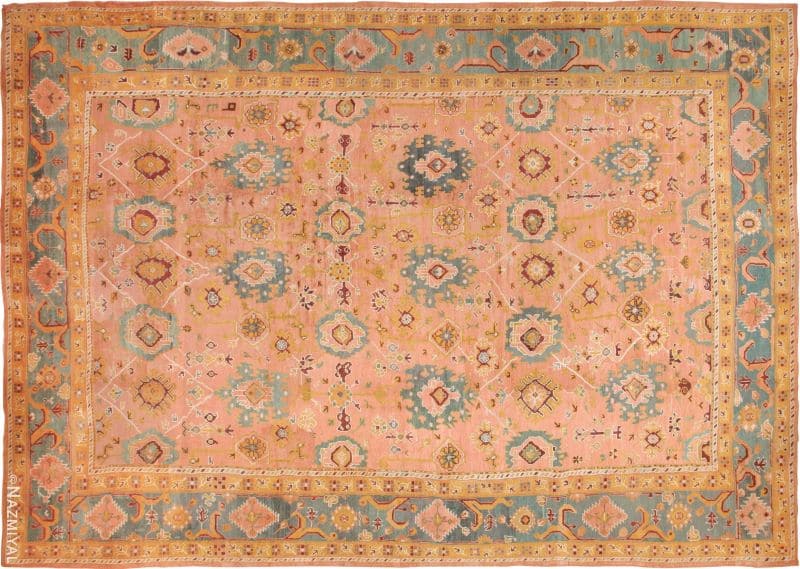
Oversized Antique Arts and Crafts Turkish Oushak Rug
Another important development during the Ottoman era was the introduction of animal designs in carpets. These fascinating Turkish rugs feature medallions decorated with animal motifs and designs.
The early Ottoman period also saw the introduction of the Crivelli Star and Ghirlandaio styles. Those styles also played on the popular central medallion format. All of these advances elevated the already vaulted craft, and the internal demand for such carpets rose sharply.
Perhaps the most important developments in the weaving of Turkish rugs occurred in the important historical weaving center of Oushak. The ancient Turkish city of Oushak had already been producing rugs for centuries.
The Oushak rugs were widely celebrated and acknowledged to be among the very best of all Oriental carpets. During the sixteenth and seventeenth century, the Ottomans oversaw a series of important changed in the weaving of Oushak rugs.
During this time, we witness the emergence of star-shaped and circular medallions. Further, elaborate arabesques and complex vine scrolls soon became common in the finest Turkish Oushak carpets.
These rugs featured intricately detailed fields flowing over with winding detail elements soon coming heavily into vogue. At this time, the Safavid rulers of Persia were also overseeing aesthetic changes in their carpet production, and the ornate and intricate carpets that were coming out of Tabriz and Kashan had an important influence of the style of Turkish rugs that were being woven.
Further important developments occurred during the reign of the Ottoman Empire which stretched into the late seventeenth century. At this time, niched prayer rugs began to be produced and shortly thereafter we see the emergence of the double niched prayer design rugs.
These important productions were exceptionally important, especially to the Islamic cultures that were the foundation of the Ottoman’s empire. Many practicing Muslim would utilize such pieces during their daily prayers.
The Turkish rugs that were manufactured throughout western Turkey also began to come into their own during this time. By the middle of the nineteenth century, the West was caught up in a tremendous Oriental revival.
It is during this time that the Turkish rugs were considered to be especially fashionable. Even the rustic tribal carpets woven in traditional rug weaving villages proved popular with Western consumers, who admired such pieces for their cultural verisimilitude.
Over the centuries, Turkish rugs have developed both as the result of internal sociopolitical changes as well as the influences and demands of the Western world. A storied craft with one of the richest bodies of material in the world, the art of Turkish rug weaving is an important facet of our shared history.
The rich and fascinating world of Turkish rugs offers insight into the culture and traditions of a region, and it also offers insight into the nature of our humanity.
Why Designers and Decorators Clamor For Turkish Rugs
Fine antique Turkish rugs are loved by many for their lustrous pastels, beautifully stylized arabesques and monumental botanical designs. Anatolia (the modern day country of Turkey) played an indispensable role introducing Oriental carpets to Europe and creating many elaborate wool rugs that appeal to Western designers and consumers of today.
Turkey produces a tremendous variety of symbol-filled Anatolian rugs, palatial medallion carpets and decorative rugs that feature an assortment of Safavid Persian symbols and patterns depicted in a distinctly Turkish manner. With their muted tones with brighter highlights, they make extremely coveted decorative pieces for any interior designer.
Oushak, Konya, Milas, Sivas, Ghiordes and the Ottoman rug and textile weaving centers and people in Hereke, all produce a number of distinctive carpet styles. Each one offers specific highlights and patterns for any type of room and design an interior designer is trying to achieve.
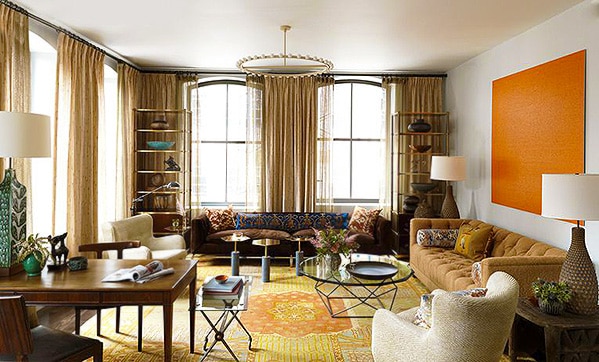
Interior Design With Antique Oushak Turkish Rugs
The legendary Turkish prayer rugs with their decorative pillars, angular mihrab and red ground are regional icons as are the splendid medallion rugs, fluid Safavid-style arabesques and angular botanical decorations, which are incomparably elegant and stylish. The rugs bring together the designs of the room, accentuating and complementing the furniture.
Exquisite oxidized colors, posh pastels and whimsical botanical designs make Turkish rugs essential designer carpets for rustic spaces and palatial drawing rooms alike. With multiple patterns and sizes, it’s obvious to see why they’re a popular choice for interior designers trying to create a elegant and pulled together look.

